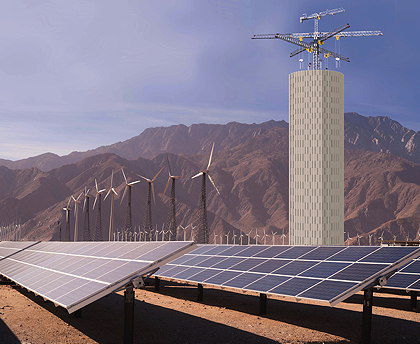- Home » News » Technology News
Regen drives are key to 'cheaper than coal' energy storage system

Powerful motors and regenerative drives are at the heart of a novel gravity-based energy storage technology being developed by a Swiss company called Energy Vault. When there is a surplus of energy, the system will use cranes to lift and stack 35-tonne concrete composite blocks to form towers up to 120m high. When energy is costly or in short supply, the system will lower the blocks to the ground to generate electricity through regeneration.
The technology is intended, in particular, to ensure continuous outputs from intermittent sources of energy such as wind and solar power. It will store energy when these plants are operating at high outputs, and release it when winds are light, or the sun is not shining. For the first time, says Energy Vault, it is offering a system that can deliver power around the clock for less than the price of fossil fuels.
Compared to other storage technologies, such as batteries, the Energy Vault system promises: low costs (the electricity will cost around 6 US cents per kWh); long operating lives of more than 30 years with no degradation in performance; roundtrip efficiencies of 80-90%; and the avoidance of potentially polluting materials such as lithium and lead.
The technology was inspired by pumped-storage hydroelectric schemes which rely on gravity and the movement of water to store and discharge electricity. But the concrete block system costs less to build, is more efficient, does not need specific topographies to operate, and avoids potentially negative impacts on the environment.
The technology has already attracted $110m of funding from the massive Japanese investor, SoftBank – its first investment in the energy storage market.

A key to the Energy Vault technology is the software that it uses to control the automated lifting and lowering operations of the six-arm crane that is at the core of each tower. Proprietary algorithms take into account factors such as energy supply and demand levels, grid stability and weather conditions. The system also incorporates machine vision technology.
The first large-scale prototype of the Energy Vault technology is due to start operating within months in Northern Italy, and will use six 1.3MW motors and high-efficiency regenerative inverters supplied by Nidec ASI.
The Indian utility Tata Power has signed an agreement for a similar 35MWh system with a peak output of 4MW, which will be able to deliver full power within 2.9s of being requested.
Energy Vault envisages modular plants with storage capacities up to 80MWh, capable of delivering up to 8MW of continuous power for periods of up to 16 hours.





